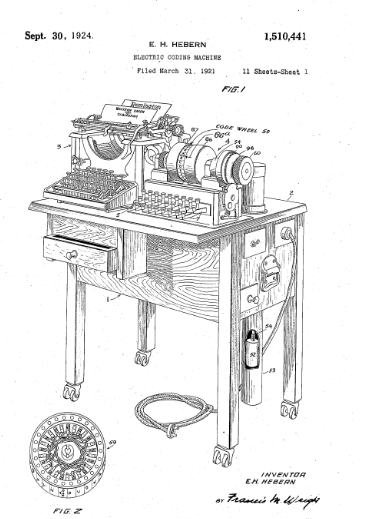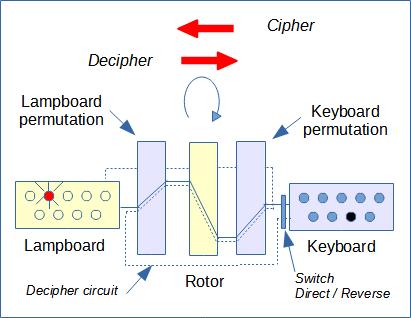Hebern 1 rotor cipher machine
Hebern's machines Home Page
- Hebern 1 rotor cipher machine, home
- The concept of Rotor
- The mathematical vision of the machine
- A paper emulator
- An authentic message
- Cryptanalysis
- Simulator
- Utilities
- The Bible
(set of simple exercises) - Challenge
Introduction
In 1917, the American Hebern invented a cipher machine, the encryption element of which was a rotor. Hebern (simultaneously with Scherbius) invents the Rotor as a ciphering element. In 1921, he patented his invention.
 |
 |
History of the machine
Note: The history of Hebern machines and American encryption machines overall is not easy to reconstruct. Indeed, the different sources give information that is often contradictory and often undated or dated but each time different.In 1917, Hebern invented a cipher machine whose encryption element was a rotor.
At the beginning of 1921, he presented his machine in a Navy magazine and presented his machine as "unbreakable". Miss Agnes Meyer (Agnes Driscol after she gets married), cryptanalyst in the Navy's Code and Signal Section, solved the sample message. Hebern goes to Washington, files a patent for his machine and presents it to Navy. Although his message has been deciphered, the Navy is very interested because it wishes (like most navies in the world), to equip itself with encryption machines. Also in 1921, Hebern created the company "Hebern Electric Code" with a capital of one million dollars.
The rest of the story of Hebern's machines is described in the page concerning the 5-rotors machine ( link).
Low production
Not much is known about the sales of the first model of Hebern's machine (1-rotor). In any case, Hebern sold very few machines.
The Ku-Klux-Klan was one of the first clients of the company created by Hebern (a photo of the model used by the KKK can be seen in the collection of the National Cryptologic Museum).
Nick Gessler (see References), tells us that the Pacific Steamship Company acquired seven 1-rotor machines in 1925 for $120 each. Eventually the British Admiralty would have acquired 2 machines also in 1925. The machine belonging to Mark Sim's collection bears the number 6, which suggests that there were at least 5 other machines built of the same model. Another machine of the same type (keyboard of a Remington typewriter), bears the serial number 10 (cf. Web links CHM). Here are the dimensions: 5 in x 8 1/2 in x 7 1/2 in.
Description
Description of the first version with printer
The first version of this machine is made up of two typewriter keyboards which allow you to enter text (clear or encrypted). One of the keyboards is part of a complete typewriter that prints the result (encrypted or plain). Between the keyboards and the part of the system that prints, there is a rotor that swaps the letter entered. Each time we press a key on the keyboard (i.e. each time we encrypt or decrypt a letter), the rotor advances one step before the encryption or decryption operation. As a result, the permutation changes with each letter entered. After a complete revolution of the rotor, we return to the first permutation. The rotor swaps the 26 letters of the alphabet, so the key must indicate the initial position of the rotor before encryption.
Description of the following version with light panel
A later version is very similar to the Enigma: it has a single keyboard, a rotor and a light panel which illuminates the encrypted letter or the clear letter depending on whether the clear letter or the encrypted letter is entered on the keyboard. A switch allows you to switch from encryption mode to decryption mode (Direct/Reverse). In the encryption mode the electric current passes from the keyboard to the rotor, passes through it from right to left, then passes to the light panel. In Reverse mode, current flows from left to right.
Notes:
- By convention (this is part of the key), you can encrypt in decryption mode (Reverse) and decrypt in encryption mode (Direct), which doubles the key space. We recall that in the case of Enigma, because of the reflector, encryption and decryption are symmetrical: if you enter the plain letter you get the ciphered letter and if you enter the cipher letter you get the plain letter without the need for a switch.
- The rotor invented by Hebern is symmetrical (unlike that of Scherbius). It is therefore possible to reverse it, which doubles the key spaces.
- In terms of machine construction (basic key), it is possible to move the rotor clockwise or counterclockwise. In 1919 model, the rotor advances in trigonometric direction. In 1924 model, the rotor advances clockwise. On the other hand, in cipher mode, the current passes through the rotor from right to left in the 1-rotor version, and from left to right in the 5-rotors version (link).
As for the basic key (inherent in the construction of the machine), there is the wiring that connects the keyboard to the rotor and the wiring that connects the rotor to the light panel. These wirings are called Keyboard and Lampboard respectively. From a mathematical point of view, they behave like a stationary rotor (stator). You must know these wirings as well as that of the rotor if you want to simulate the operation of the machine.
Conclusion
- The basic key is the Lampboard, Keyboard and Rotor wiring as well
as the direction of movement of the rotor (clockwise or
trigonometric). The basic key includes whether the rotor advances
(or not) before encryption. For a mechanical machine (Hebern,
Enigma), pressing a key will mechanically advances the front
rotor(s) to establish electric current. On the other hand,
for a machine based on relays or electronics, we can imagine that
progress could be made after encryption.
Note: we can imagine that we have several Rotors available and that for encryption, we choose one of the rotors.
- The message key consists of:
- The rotor used (if several rotors are available).
- The initial position of the rotor.
- Positioning the rotor in one direction or the other.
- The encryption mode (direct/reverse)
In total: the length of the key is therefore 26x2x2 = 104 (2 to the power of 7), which is very small. If we have several rotors, we increase the length of the key accordingly. Due to the short length of the key, the security of the Hebern machine relies essentially on the secrecy of the machine itself. If it falls into the hands of the enemy, it no longer offers any protection of messages, which is contrary to the Kerckoffs principle which insists that the security of a means of encryption must rest essentially on the key. In the case of an encryption machine, respect for the Kerchoffs principle assumes that the Enemy has the encryption machine (whether he bought it or captured it).
References
-
Cryptanalysis of the single rotor cipher machine, by
Donald A. Dawson, Aegean Park Press, 1996.
Note: This book dedicated to the cryptanalysis of the Hebern 1 rotor machine, also contains a presentation of this machine and a brief history of the first rotor machines.
Web Links
- Wikipedia - Hebern rotor machine - (link).
- Hebern and his Electric Code Machine, by Ralph Simpson
(link).
Note: You can see several photos there; including a photo of a Hebern 1 rotor machine using a light panel (like the Enigma); another of Edward Hebern; a drawing (from the patent) which represents the machine using typewriters; a photo of a rotor fitted to the Hebern 5 rotor machine; finally, a photo of the Hebern Electric Code Company factory in Oakland, California. -
HEBERN ELECTRIC CODE MACHINE, by Jerry Proc
(link).
Note: You can see several photos there. In particular a photo of the heart of a Hebern 1 rotor machine (the one using typewriters). We can clearly see the rotor and the alphabetical index of the connections. Another (exceptional) photo shows a woman using the machine. The caption states that the photo was taken in March 1923 in a Western Union Telegram office in Washington. -
HEBERN ELECTRIC CODE MACHINE, by Jerry Proc
(link).
We can see several photos there which represent a 1-rotor Hebern machine using a light panel. - CHM (Computer History Museum) - Title: Hebern Electric Code Machine - (link). Another link with photo: (link).
-
NSA - Friedman documents - ID A273618 - This document describes
(in broad terms) the Hebern 1 rotor machine.
(
link).
Note: We learn that the patent application for the Hebern 1 rotor machine was filed on March 31, 1921. The patent dates from September 30, 1924. - Espacenet - Pattent - US1510441 - A Electric coding machine - Request: 1921, Pattent: 1924 - ( link). Note: A priori this is the patent for the Hebern 1 roto machine.
- Nick Gessler - The Hebern Code Machine. (link).